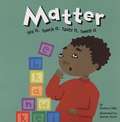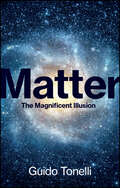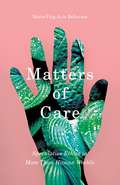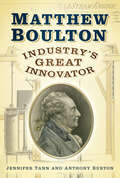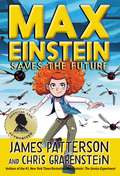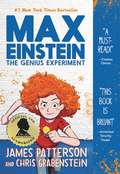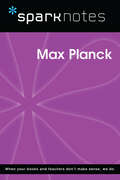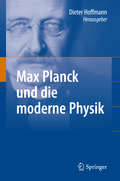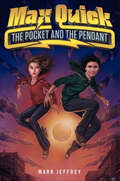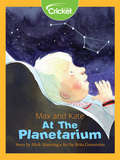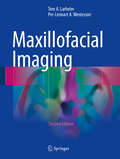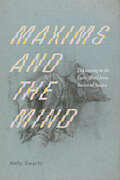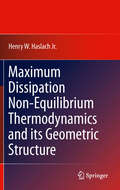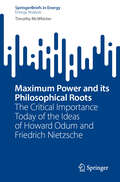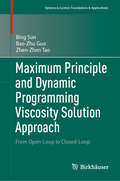- Table View
- List View
Matter: See It, Touch It, Taste It, Smell It
by Darlene R. StilleThe book describes matter and its different states --solids, liquids, and gases--with experiments.
Matter: The Magnificent Illusion
by Guido TonelliWhat are we made up of? What holds material bodies together? Is there a difference between terrestrial matter and celestial matter – the matter that makes up the Earth and the matter that makes up the Sun and other stars? When Democritus stated, between the fifth and fourth centuries BCE, that we are made up of atoms, few people believed him. Not until Galileo and Newton in the seventeenth century did people take the idea seriously, and it was another four hundred years before we could reconstruct the elementary components of matter. Everything around us – the matter that forms rocks and planets, flowers and stars, even us – has very particular properties. These properties, which seem quite normal to us, are in fact very special, because the universe, whose evolution began almost fourteen billion years ago, is today a very cold environment. In this book, Guido Tonelli explains how elementary particles, which make up matter, combine into bizarre shapes to form correlated quantum states, primordial soups of quarks and gluons, or massive neutron stars. New questions that have emerged from the most recent research are answered: in what sense is the vacuum a material state? Why can space-time also vibrate and oscillate? Can elementary grains of space and time exist? What forms does matter assume inside large black holes? In clear and lively prose, Tonelli takes readers on an exhilarating journey into the latest discoveries of contemporary science, enabling them to see the universe, and themselves, in a new light.
Matters of Care: Speculative Ethics in More than Human Worlds (Posthumanities #41)
by María Puig de la BellacasaTo care can feel good, or it can feel bad. It can do good, it can oppress. But what is care? A moral obligation? A burden? A joy? Is it only human? In Matters of Care, María Puig de la Bellacasa presents a powerful challenge to conventional notions of care, exploring its significance as an ethical and political obligation for thinking in the more than human worlds of technoscience and naturecultures. Matters of Care contests the view that care is something only humans do, and argues for extending to non-humans the consideration of agencies and communities that make the living web of care by considering how care circulates in the natural world. The first of the book&’s two parts, &“Knowledge Politics,&” defines the motivations for expanding the ethico-political meanings of care, focusing on discussions in science and technology that engage with sociotechnical assemblages and objects as lively, politically charged &“things.&” The second part, &“Speculative Ethics in Antiecological Times,&” considers everyday ecologies of sustaining and perpetuating life for their potential to transform our entrenched relations to natural worlds as &“resources.&” From the ethics and politics of care to experiential research on care to feminist science and technology studies, Matters of Care is a singular contribution to an emerging interdisciplinary debate that expands agency beyond the human to ask how our understandings of care must shift if we broaden the world.
Matthew Boulton: Enterprising Industrialist of the Enlightenment (Science, Technology And Culture, 1700-1945 Ser.)
by Sally BaggottMatthew Boulton was a leading industrialist, entrepreneur and Enlightenment figure. Often overshadowed through his association with James Watt, his Soho manufactories put Birmingham at the centre of what has recently been termed 'The Industrial Enlightenment'. Exploring his many activities and manufactures-and the regional, national and international context in which he operated-this publication provides a valuable index to the current state of Boulton studies. Combining original contributions from social, economic, and cultural historians, with those of historians of science, technology and art, archaeologists and heritage professionals, the book sheds new light on the general culture of the eighteenth century, including patterns of work, production and consumption of the products of art and industry. The book also extends and enhances knowledge of the Enlightenment, industrialization and the processes of globalization in the eighteenth century.
Matthew Boulton: Industry's Great Innovator
by Anthony Burton Jennifer TannMatthew Boulton, of the famous Boulton & Watt steam engine partnership, was an eighteenth-century designer and inventor. Before he partnered up with James Watt he was a successful industrialist manufacturing a range of silver and plated goods, buttons and buckles, and the sort of knickknackery known at the time as ‘toys’. He had a business network throughout continental Europe with travelling agents who represented his various interests. Without his commercial skills, Watt would probably have failed to bring his steam engine to market, but in due course Boulton started the process that would revolutionise the world of industry and transport: the engine was exported all over the world. Boulton was an affable man who enjoyed company and creative conversation. He was also a founder member of the Lunar Society and became a fellow of the Royal Society. This exciting new book, the first full-length biography of Matthew Boulton since H.W. Dickinson’s excellent publication in 1937, is the culmination of twenty years’ original research and brings to life one of the most colourful characters of the Industrial Revolution.
Mauritius SCIENCE Grade 7 (Part-I) - MIE
by Mauritius Institute of EducationSCIENCE Grade 7 (Part-I) Textbook from Mauritius Institute of Education
Mauritius SCIENCE Grade 7 (Part-II) - MIE
by Mauritius Institute of EducationSCIENCE Grade 7 (Part-II) Textbook from Mauritius Institute of Education
Max Bense: Werk - Kontext - Wirkung (Abhandlungen Zur Philosophie Ser.)
by Claus Zittel Andrea Albrecht Masetto Bonitz Alexandra SkowronskiMax Bense (1910–1990) gilt als Vorreiter der Computerkunst und der Technikphilosophie und war ein engagierter Förderer von Kunst und Literatur, Promotor interdisziplinären Denkens und politischer Provokateur. Häufig ist es bei der Auseinandersetzung mit Bense jedoch bei diesen Etikettierungen geblieben. Der Sammelband nimmt daher eine konzertierte Neuaufnahme der Diskussion von Max Benses Arbeiten aus literaturwissenschaftlicher, philosophie- und wissenschaftshistorischer sowie aus medien- und ästhetiktheoretischer Perspektive vor. Er versammelt Beiträge zu Themenkomplexen wie der Semiotik, Technikphilosophie, experimentellen Poesie und Ästhetiktheorie, zu Benses lokalen und internationalen Kontakten und Netzwerken sowie zu seinem publizistischen Verhalten im Nationalsozialismus und in der Nachkriegszeit.
Max Einstein: Rebels With A Cause (Max Einstein #2)
by James Patterson Chris Grabenstein<P><P>Max Einstein is the first and only children's adventure series officially approved by the Albert Einstein Archives. Max Einstein's typical day is not your average 12-year-old's. <P><P>She...- TEACHES classes at a New York college- Dodges KIDNAPPING attempts with her best friends- Goes on SECRET MISSIONS for her billionaire boss- Has a MYSTERIOUS CONNECTION to Albert Einstein <P><P>Just a day in the life of the Change Makers Institute's top agent! What does an Irish town and a village in India have in common? A water crisis that only a group of kid geniuses can fix! Max and her CMI friends attempt to use their smarts to find solutions, but it's hard to save the world when you're trying not to be kidnapped! A greedy corporation with an eye on capturing Max seems to know their every move. It's almost like the bad guys have a spy inside the Change Makers... <P><P><b>A New York Times Bestseller</b>
Max Einstein: Saves the Future (Max Einstein #3)
by James Patterson Chris GrabensteinThe world's #1 bestselling author has teamed up with the world's most famous genius to entertain, educate and inspire a generation of kids--with the first and only kids' book series officially approved by the Albert Einstein Archives.Albert Einstein + James Patterson = A Must Read! Max is back with a thrilling new adventure that involves time travel, creepy bad guys, killer drones, and a shocking mystery about her past that she will stop at nothing to solve! Under constant danger of being kidnapped by the shadowy Corporation, Max is on the run from New York to London and beyond. But soon the call comes for the Change Maker kids' next mission: make sure no kid ever goes hungry again! If anyone can tackle a problem this big, Max and her genius friends can. But mysterious clues about her past keep distracting Max's focus. She always wanted to know who her parents were and why they abandoned her as a baby. If she manages to build a time machine, she could find them and get all the answers! What's more important - her past, or the future of the Change Makers?
Max Einstein: The Genius Experiment (Max Einstein #1)
by James Patterson Chris GrabensteinWhat Harry Potter did for magic, Max Einstein does for kids' imaginations! Max leads a group of kid geniuses in this #1 New York Times bestseller officially approved by the Albert Einstein archives.Max Einstein is not your typical genius. She . . .Hacks the computer system at NYU to attend classesBuilds inventions to help the homelessAnd talks to Albert Einstein! (Okay, that's just in her imagination)But everything changes when Max is recruited by a mysterious organization! Their mission: solve some of the world's toughest problems using science. She's helped by a diverse group of young geniuses from around the globe as they invent new ways to power the farthest reaches of the planet. But that's only if the sinister outfit known only as The Corporation doesn't get to her first . . .Max Einstein is a heroine for the modern age and will be looked up to by readers for generations to come."[A] fast-paced, science-filled caper." -- The Wall Street Journal
Max Planck (SparkNotes Biography Guide)
by SparkNotesMax Planck (SparkNotes Biography Guide) Making the reading experience fun! SparkNotes Biography Guides examine the lives of historical luminaries, from Alexander the Great to Virginia Woolf. Each biography guide includes:An examination of the historical context in which the person lived A summary of the person&’s life and achievements A glossary of important terms, people, and events An in-depth look at the key epochs in the person&’s career Study questions and essay topics A review test Suggestions for further reading Whether you&’re a student of history or just a student cramming for a history exam, SparkNotes Biography guides are a reliable, thorough, and readable resource.
Max Planck und die moderne Physik
by Dieter HoffmannMax Planck (1858-1947) zählt zu den herausragenden Physikern des zwanzigsten Jahrhunderts. Seine Quantenhypothese wurde zur Grundlage für die Entwicklung der Quantentheorie und bildet eine der zentralen Säulen der modernen Physik. Damit ist Plancks Wirken jedoch keineswegs erschöpfend charakterisiert: In diesem Buch arbeiten anerkannte Physikhistoriker das gesamte Spektrum von Plancks physikalischem Schaffen heraus und würdigen seine Bedeutung für die Entwicklung der modernen Physik.
Max Quick: The Pocket and the Pendant
by Mark Jeffrey“Jeffrey’s descriptions of how time has stopped will stop readers in their own tracks. Plenty of action-adventure appeal.” — Booklist“An imaginative addition to the middle-grade speculative adventure canon.” — Bulletin of the Center for Children’s Books“This fast-paced adventure…will keep readers turning the pages. The incorporation of figures from Sumerian mythology adds an interesting element that may appeal to fans of Rick Riordan’s “Percy Jackson” series.” — School Library Journal“Riveting. The Pocket and the Pendant is not what you expect, no matter what you expect.” — Scott Sigler, New York Times bestselling author“A fresh, fun and fascinating idea deftly brought to life. With all its deeply–felt adventure, Max Quick should quickly captivate young readers.” — James Jennewein and Tom S. Parker, authors of the RuneWarriors Trilogy“A wildly imaginative romp through the vagaries of time, Max Quick leads the reader on a high–speed tour of ancient myths, alien kingdoms and some books you can really throw yourself into. Terrific adventure at breakneck speed.” — Richard Newsome, author of The Billionaire’s Curse
Max and Kate: At the Planetarium
by Mick ManningDid you know you can explore space and visit the stars from right here on planet Earth? Follow along with Max and Kate as they visit a science museum and learn about the night sky.
Max von Laue: Intrepid and True: A Biography of the Physics Nobel Laureate (Springer Biographies)
by Jost LemmerichThis biography gives an insider view of 20th century German science in the making. The discovery by Max von Laue in 1912 of interference effects demonstrated the wave-like nature of X-rays and the atomic lattice structure of crystals. This major advance for research on solids earned him the Nobel Prize two years later, the ultimate acclaim as an exceptional theoretician. As an early supporter of Einstein’s relativity theory, he published fundamental papers on light scattering as well as on matter waves and superconductivity. Laue may be counted among the few persons of influence in Germany who – as Einstein put it – managed to “stay morally upright” under Nazism. It is thus surprising that this is the first extensive biography of this famous scientist.Jost Lemmerich could hardly have been better equipped to describe German physics and physicists in the 1920s. His copiously illustrated historical account is based as much on scientific material as on private correspondence, creating a fascinating and convincingly detailed portrait.
Maxillofacial Imaging
by Per-Lennart A. Westesson Tore A. LarheimThis book demonstrates how advanced medical imaging techniques can be successfully applied to dental and maxillofacial conditions. There is a focus on CT and MRI, but the use of all contemporary imaging techniques are illustrated including PET, PET/CT, ultrasonography, and cone beam CT. The presentation is in atlas style, with succinct, bulleted text and a wealth of high-quality images in multiple planes. All images for each patient are grouped to enable the reader very quickly to gain an imaging overview of the condition under consideration. After a comprehensive introductory chapter on normal imaging anatomy, the role of advanced imaging techniques is described in pathologic conditions of the mandible and maxilla, temporomandibular joint, regions closely related to the jaw, paranasal sinuses, oral cavity, salivary glands, and structures adjacent to the maxillofacial region. A concluding chapter examines the use of interventional procedures for diagnosis and treatment of maxillofacial conditions. Compared to the first edition, numerous additional cases have been incorporated and a completely new chapter focuses on cone beam CT. The book will be useful for oral and maxillofacial radiologists, oral and maxillofacial surgeons, dentists, radiologists, plastic surgeons, head and neck surgeons, and others who work with maxillofacial conditions.
Maxims and the Mind: Unknowing in the Early Novel from Bacon to Austen
by Kelly SwartzCorrecting the misunderstood role of maxims at the intersection of early science and literature Eighteenth-century novels are full of maxims—pithy statements of received wisdom such as &“necessity is the mother of invention&” or &“neither a borrower nor a lender be.&” Maxims are ancient rhetorical forms, celebrated by no less an influential figure than Aristotle as powerful tools of persuasion. Critics have generally explained away their ubiquitous presence in eighteenth-century novels as a vestige of a premodern form. As Kelly Swartz explains, however, their presence illustrates an important yet often overlooked aspect of the novel&’s relationship with the early empirical sciences. Applying insights from Francis Bacon&’s account of aphorizing as a method of scientific writing to works by Aphra Behn, Jonathan Swift, Samuel Richardson, and Jane Austen, Swartz shows how maxims functioned in a critical role that she calls &“unknowing.&” Such expressions, she argues, represented the not yet known as a way to inspire in readers a desire for ongoing, collective inquiry. Maxims also allowed these authors to invent unknowing fictional minds, at once attractive and vexing, ranging from the incoherent and banal to the unintelligibly rich. Maxims and the Mind thus offers new insight into the nature of the relationship between science and the early novel, emphasizing their shared interest in the representation of knowledge still awaiting discovery.
Maximum Dissipation Non-Equilibrium Thermodynamics and its Geometric Structure
by Henry W. Haslach Jr.Maximum Dissipation: Non-Equilibrium Thermodynamics and its Geometric Structure explores the thermodynamics of non-equilibrium processes in materials. The book develops a general technique created in order to construct nonlinear evolution equations describing non-equilibrium processes, while also developing a geometric context for non-equilibrium thermodynamics. Solid materials are the main focus in this volume, but the construction is shown to also apply to fluids. This volume also: * Explains the theory behind thermodynamically-consistent construction of non-linear evolution equations for non-equilibrium processes * Provides a geometric setting for non-equilibrium thermodynamics through several standard models, which are defined as maximum dissipation processes * Emphasizes applications to the time-dependent modeling of soft biological tissue Maximum Dissipation: Non-Equilibrium Thermodynamics and its Geometric Structure will be valuable for researchers, engineers and graduate students in non-equilibrium thermodynamics and the mathematical modeling of material behavior.
Maximum Power and its Philosophical Roots: The Critical Importance Today of the Ideas of Howard Odum and Friedrich Nietzsche (SpringerBriefs in Energy)
by Timothy McWhirterThis Briefs volume focuses on the maximum power principle, which was created by the mathematician and physical chemist Alfred Lotka, and further developed and utilized most prominently by the systems ecologist H. T. Odum, who applied it to different physical, biological, ecological and economic systems. They both described this principle providing a thermodynamic framework for evolutionary theory. This principle has a philosophical heritage that has, until now, gone unrecognized. The 19th century philosopher Friedrich Nietzsche viewed his concept of the will to power as an empirical principle that describes how organic and inorganic systems develop in ways that grow in power. This book describes this interdisciplinary story: it discusses the development of both principles, reviews the empirical and theoretical support for them, critically examines their alleged limitations, and describes their philosophical implications, evidenced in a particularly provocative manner by Nietzsche's and Odum's critiques of moral and religious values.
Maximum Principle and Dynamic Programming Viscosity Solution Approach: From Open-Loop to Closed-Loop (Systems & Control: Foundations & Applications)
by Bing Sun Bao-Zhu Guo Zhen-Zhen TaoThis book is concerned with optimal control problems of dynamical systems described by partial differential equations (PDEs). The content covers the theory and numerical algorithms, starting with open-loop control and ending with closed-loop control. It includes Pontryagin&’s maximum principle and the Bellman dynamic programming principle based on the notion of viscosity solution. The Bellman dynamic programming method can produce the optimal control in feedback form, making it more appealing for online implementations and robustness. The determination of the optimal feedback control law is of fundamental importance in optimal control and can be argued as the Holy Grail of control theory. The book is organized into five chapters. Chapter 1 presents necessary mathematical knowledge. Chapters 2 and 3 (Part 1) focus on the open-loop control while Chapter 4 and 5 (Part 2) focus on the closed-loop control. In this monograph, we incorporate the notion of viscosity solution of PDE with dynamic programming approach. The dynamic programming viscosity solution (DPVS) approach is then used to investigate optimal control problems. In each problem, the optimal feedback law is synthesized and numerically demonstrated. The last chapter presents multiple algorithms for the DPVS approach, including an upwind finite-difference scheme with the convergence proof. It is worth noting that the dynamic systems considered are primarily of technical or biologic origin, which is a highlight of the book. This book is systematic and self-contained. It can serve the expert as a ready reference for control theory of infinite-dimensional systems. These chapters taken together would also make a one-semester course for graduate with first courses in PDE-constrained optimal control.
Maximus the Confessor and Evolutionary Biology: The Phylogenetic Logoi (Routledge Science and Religion Series)
by Andrew P. JacksonThis book brings Maximus the Confessor’s logoi doctrine into dialogue with modern-day evolutionary biology. It explores the extent to which the logoi, as described by Maximus, exhibit features that are concordant with evolution before going on to consider more discordant aspects that cannot be ignored. The author addresses the curious resonance between the logoi and evolution in a systematic way through a close reading of primary textual material allied with a deep understanding of both the classical Darwinian and ‘extended’ evolutionary syntheses. The study joins with other Maximian interpreters in attesting to the incarnational and theophanic nature of the logoi, but seeks to extend this distinctively Eastern Christo-cosmology into the problematic territory of biological evolution, a territory historically dominated by Western scholarship. The book will be of interest to scholars of religion and science, as well as Patristics and the Eastern Orthodox theological traditions.
Maxine and the Greatest Garden Ever
by Ruth SpiroBest friends Maxine and Leo combine their maker and artistic skills to create (and save!) the ultimate garden in this empowering, STEM-focused picture bookAfter sketching and plotting and planting, Maxine and Leo know they've made The Greatest Garden Ever! But they're not the only ones who think so. Soon, all sorts of animals make their way in, munching on carrots and knocking over pots. When Leo and Maxine can't agree on a way to deter these unwelcome critters, it looks like there's more on the line than saving their garden--they just might need to save their friendship too.
Maxwell's Demon 2 Entropy, Classical and Quantum Information, Computing
by Harvey S Leff Andrew F RexOver 130 years ago, James Clerk Maxwell introduced his hypothetical "demon" as a challenge to the scope of the second law of thermodynamics. Fascination with the demon persisted throughout the development of statistical and quantum physics, information theory, and computer science, and links have been established between Maxwell's demon and each of
Maxwell's Demon: Why Warmth Disperses and Time Passes
by Hans Christian von BaeyerAmazon.com Review What's the most depressing law of physics? Why, the second law of thermodynamics, of course! In a nutshell: entropy (or disorder) is always increasing, leading to the inevitable "heat death of the universe." Quite a dismal prospect, but even the most optimistic don't expect to be around when it all ends, long after our sun burns out. In Maxwell's Demon: Why Warmth Disperses and Time Passes, physics professor Hans Christian von Baeyer tells the story of the discovery and development of the second law of thermodynamics. The book is named for James Clerk Maxwell's little imaginary genius, who could make your latte boil out of your travel mug given a chance. Von Baeyer treats us to a wide-ranging survey of the early days of thermodynamics, the demon's multiple deaths and rebirths, and an explanation of why entropy's not such a bad thing after all.
